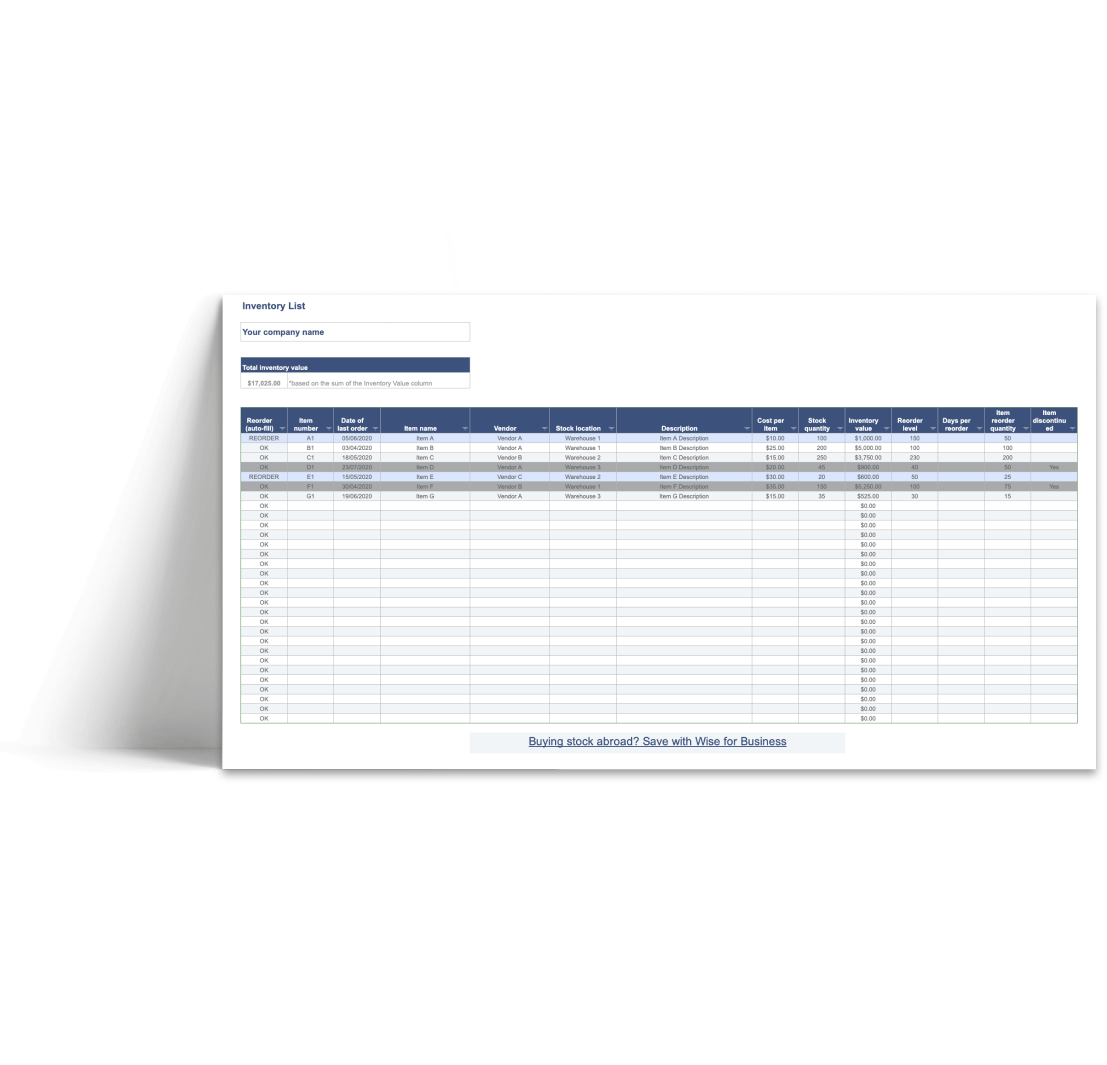Inventory Management

What is inventory management?
Having a good small business inventory management system in place can mean you have happier customers and a better profit margin. Sounds good, right?
Inventory management involves the end to end processes needed to get the stock you need to the right place, at the right time, and for the right cost.
Ordering and storing products, stocktaking to check the amount of inventory you have on hand at any given time, ensuring order fulfilment and stopping shrinkage are all part of inventory management.

Wise is the cheaper, faster way to send money abroad.
Effective inventory management processes can save your business money and boost your profit margin.
If you’re buying inventory from overseas or paying invoices in a foreign currency, using Wise Business to pay suppliers can save you even more.
With the Wise Business account, you’ll receive your own bank details for the US, UK, euro area, Poland, Australia and New Zealand - no matter where in the world you live. That means you can make and receive fee-free payments from these regions.
Hold more than 40 currencies in your account and easily switch between them using the mid-market exchange rate with no mark-up. That means no surprises and no sneaky fees - saving you money compared to using an alternative provider or your regular bank.
Sign up now and do business without borders.
Why is inventory management important?
With sound inventory management processes, you can get clear visibility of what stock your business holds, and where it is.
That means you can reduce excess stock on hand, cutting storage costs, decrease the margin of error for out-of-stocks and make sure you have the right product in the right place at the right time. This can boost your bottom line.
Inventory management also lets you forecast the stock you’ll need based on sales performance, and gain insights into customer behaviour and trends based on their purchases.
Manage your inventory successfully with one of our inventory templates. Choose which format you prefer, Excel or Google Sheets, download and get started.

What are the four types of inventory?
To create an effective inventory management plan for your business, you’ll need to understand the four most common ways inventory is classified:
Raw materials
If you create your own products to sell, you may need to hold a raw materials inventory detailing the materials you have on hand to create your finished products.
Work-in-progress
A work-in-progress (WIP) inventory can be a useful bigger picture tool, as it covers everything you need to make and ship your products, end-to-end. As well as recording raw materials which have been released from inventory to be used in production, you’ll also need to detail materials which are in the process of being made into finished items, and even things like packaging.
Finished goods
A finished goods inventory includes any product that is completed, signed off for quality, and therefore ready for sale to your customers.
Overhaul / MRO
MRO stands for Maintenance, Repair and Operating Supplies. This type of inventory is a record of everything needed to create and sell the final product, but not the product itself. Think consumables used in production, such as oil or lubricant for machines, or even paper and pens used by the designers coming up with product ideas.

How to manage your inventory.
Successful inventory management relies on good quality data about what stock you have, where. That means tracking your inventory accurately is essential.
You can track your inventory for free in Excel or Google Sheets. Check out our handy free inventory management templates to help get you started.
Google sheets inventory templates
If you have a more complex or well established business you might decide to pay for software to help track your stock levels. Take a look at our software comparison table for more on the features and benefits of some of the top inventory management software for small businesses.
However you want to track your inventory, it’s worth understanding the basic approaches to inventory management for small businesses which are outlined in the table below.

Inventory management methods and best practices.
Inventory management methods and best practices.
| Method | Description | How this method could benefit you |
|---|---|---|
ABC analysis | ABC analysis is an inventory categorization technique that splits your stock into three categories, your most valuable products, middle of the road products and products whose value is small but order quantity is large | ABC inventory analysis helps you better allocate your time and resources to the products that will bring you the most value. |
Backordering | Backordering allows you to take orders and payments for out-of-stock products | Backordering can increase your sales, cash flow, and profit, and means you're at no risk of overstocking. However, if you can't re-stock in time you risk customer dissatisfaction and potential loss of return business. |
Bulk shipments | Bulk shipping means you purchase and ship your inventory in bulk. | It is usually cheaper to buy and ship in bulk, which means bulk shipments could save you money. This technique is best applied to goods with high demand to make the most of cheaper rates for bulk buying and selling. |
Just-in-time (JIT) | Just-in-time is an inventory management technique where you only purchase your inventory a few days before it is needed. | JIT inventory management lowers your stock holding costs and reduces the risk of deadstock. |
Dropshipping | Dropshipping is a method of inventory management where you pass on order details to your manufacturer or wholesaler, who then handles shipment of orders for you. | Dropshipping reduces the cost of holding inventory to zero. |
Small business inventory management software.
You might want to consider inventory management software to help track your inventory.
Some inventory management solutions come with a hefty price tag. However, by thinking carefully about the needs of your business, you can find the right one for you. Below we’ve outlined a few affordable options, along with some of the most important features of inventory management software, to help you choose.
If you’re just getting started with your business, keeping your costs down is essential. You can also manage your inventory for free in Excel or Google Sheets. We’ve even created some handy templates to help you out.
Excel inventory management templates
Google sheets inventory management templates
If you’re buying or selling inventory in multiple currencies, you could benefit from the Wise Business account. Send and receive money from all over the world using the real exchange rate, and with no hidden fees.
| Zoho Inventory | Quickbooks Desktop Enterprise | inFlow | |
|---|---|---|---|
Plans start from | $29 a month | $75.60 a month | $79 a month |
Free trial | 14 days | 30 days | 14 days |
Supply chain management | ✓ | ✓ | ✓ |
Just-in-time inventory | ✘ | ✓ | ✘ |
Interface with POS (point of sale) | ✓ | ✓ | ✘ |
Low inventory warning | ✓ | ✓ | ✓ |
Backorder partial shipment | ✓ | ✓ | ✓ |
Dropshipping | ✓ | ✓ | ✓ |
Attach photo to item code | ✓ | ✘ | ✓ |
Scan item barcode from smartphone | ✓ | ✘ | ✓ |
Multiple currency support | ✓ | ✓ | ✓ |
Inventory management FAQs.
Save time and money with Wise Business
Grow your business by connecting with customers, suppliers and staff all over the world.